Reinforce your understanding of LPN/LVN nursing skills — and prepare for the NCLEX-PN® exam! Corresponding to the chapters in Foundations of Nursing, 9th Edition, this study guide provides a variety of exercises to help you review, practice, and apply nursing concepts and principles. Review questions make it easier to achieve the chapter objectives from the textbook, and critical thinking activities help you develop clinical judgment skills. Now with Next Generation NCLEX® (NGN)-style case studies and questions, this guide provides you with an effective study tool for the NGN exam.
Study Guide for Foundations of Nursing, 9th Edition
KSh 7,280.00
Reinforce your understanding of LPN/LVN nursing skills — and prepare for the NCLEX-PN® exam! Corresponding to the chapters in Foundations of Nursing, 9th Edition, this study guide provides a variety of exercises to help you review, practice, and apply nursing concepts and principles. Review questions make it easier to achieve the chapter objectives from the textbook, and critical thinking activities help you develop clinical judgment skills. Now with Next Generation NCLEX® (NGN)-style case studies and questions, this guide provides you with an effective study tool for the NGN exam.
2 in stock
Related products
-
Wong’s Essentials of Pediatric Nursing
Awarded first place in the 2017 AJN Book of the Year Awards in the Child Health category. Known for its accuracy, evidence-based focus, and engaging writing style, Wong’s Essentials of Pediatric Nursing, 10th Edition has been the #1 title in the pediatric nursing market since it first published in 1980! Thoroughly revised to equip you with the latest research and guidelines for treating children today, it encourages a whole-body approach by beginning with child development and health promotion to better understand the later chapters on specific health problems. A new chapter featuring all systems cancers provides comprehensive information in one place. Nursing Care Plans now incorporate additional case studies to personalize interventions and promote critical thinking.
A developmental approach clearly identifies key tasks, influences, and differences at each stage of a child’s growth to help students provide appropriate, individualized care for each child.
UNIQUE! Critical thinking case studies allow you to test and develop your analytical skills in a variety of clinical situations.
UNIQUE! Quality Patient Outcomes content in Nursing Care Management discussions for major diseases and disorders helps you understand how the care you provide directly impacts patient safety and promotes positive outcomes.
Updated genetic content in the Developmental and Genetic Influences on Children chapter addresses rapidly changing and important information as it relates to children in health and illness.
UNIQUE! Family focus includes a separate chapter on the role of the family in child health, family content throughout the text, and Family-Centered Care boxes that highlight information on patient teaching, home care, and incorporating the family in the child’s care.
UNIQUE! Translating Evidence into Practice boxes focus your attention on the application of research and critical thought processes to support and guide the outcomes of nursing care.
UNIQUE! Atraumatic Care boxes guide you through performing procedures in a caring manner, promoting more positive experiences for children, families, and nurses.
Drug Alerts throughout the text emphasize important drug information and point out potential safety issues.
An emphasis on wellness offers health promotion and injury prevention strategies for each age group.
Community Focus boxes provide resources and guidance on caring for children outside the clinical setting.
Nursing Care Plans, including Nursing Diagnoses, Patient/Family Goals, Nursing Interventions/Rationales, and Expec1ted Outcomes, provide you with a model for planning patient care.
Research Focus boxes help you remain abreast of current studies that impact pediatric nursing today.
Cultural content, integrated throughout the text and highlighted in Cultural Considerations boxes, exposes you to customs and beliefs of different cultures that influence child care, enhancing your ability to provide quality nursing care to ALL children and their families.
Nursing Tips throughout the text offer helpful hints and practical, clinical information of a non-emergency nature.
Nursing Alerts throughout the text provide you with critical information that must be considered in providing care.
UNIQUE! Emergency Treatment boxes serve as a quick reference in critical situations.
Nursing Care Guidelines boxes provide you with clear, step-by-step, detailed instructions for performing specific skills or procedures.
NEW! Updated content throughout, notably methods of measuring competency and outcomes (QSEN and others), ambiguous genitalia, pediatric measurements, guidelines, and standards as defined by the American Academy of Pediatrics, and clear definitions of adolescent and young adult, keeps you up-to-date on important topic areas.
NEW! The Child with Cancer chapter includes all systems cancers for ease of access.
NEW and UPDATED! Case Studies now linked to Nursing Care Plans to personalize interventions, while also providing questions to promote critical thinking. -
Critical Care Nursing: Diagnosis and Management 8th Edition by Linda D. Urden
Get a firm understanding and mastery of the unique issues and procedures involved in critical care nursing with Critical Care Nursing: Diagnosis and Management, 8th Edition. Praised for its comprehensive coverage and clear organization, this market-leading text offers a great foundation in the realities and challenges of today’s critical care unit that’s perfect for both nursing students and practicing nurses alike. This new edition also features enhanced integration of QSEN and interprofessional collaborative practice, plus expanded coverage of leadership, post-ICU outcomes and highly contagious infections. Revamped case studies, Patient Teaching boxes, Evidence-Based Practice boxes, Patient Safety Alerts, and other learning tools further develop your critical thinking skills and prepare you for success in high-acuity, progressive, and critical care settings.
UNIQUE! Nursing management plans of care feature approximately 35 NANDA-I nursing diagnoses to provide a detailed, ready-to-use, clinically current reference for safe, effective patient care.
Consistent organization within each body-system unit provides a systematic framework for learning and for CCRN and PCCN certification preparation. It also serves as a great reference for clinical practice.
Pharmacologic Management tables offer quick summaries of the drugs most often used in critical care.
NEW! Enhanced QSEN integration makes it easier to link text content to the various QSEN competencies through the addition of QSEN-related questions in case studies, retitled features and boxes, QSEN content icons, and highlighted QSEN information throughout.
UNIQUE! Integration of interprofessional collaborative practice incorporates the various IPEC competencies ― such as Values & Ethics for Interprofessional Practice, Roles & Responsibilities, Interprofessional Communication, and Teams & Teamwork ― into the text content and case studies.
NEW! Enhanced focus on core content directs readers’ attention to routine adult critical care situations and minimizes the attention given to issues treated by specialized facilities.
NEW! Revamped case studies feature updated scenarios and information to reflect the current “flavor” of high-acuity, progressive, and critical care settings ― with patients being seen in a variety of settings. These scenarios help readers “scaffold” learning and apply chapter content to true-to-life clinical situations.
NEW! Content on post-ICU outcomes has been added to chapters on therapeutic management and disorders to provide readers with a more holistic perspective on the critical care patient experience.
NEW! Expanded leadership content places a fresh focus on the emerging importance of nursing leadership to ensure optimal patient outcomes.
NEW! Added content on highly contagious infections has been incorporated into the chapter on sepsis to keep readers abreast of this ever-changing area of interest.
NEW! Links to 15 sample skills from Elsevier Clinical Skills give readers a foundation in mastering critical care skills.
NEW! Enhanced Patient Teaching boxes feature more specific and practical content for at-the-bedside patient care.
NEW! Additional animations have been added to the Evolve companion website.
NEW! Updated content throughout reflects changes in nursing, medical, and collaborative care of patients in high-acuity, progressive, and critical care settings. -
Ross and Wilson;Anatomy and Physiology in Health and Illness. International Edition, 14th Edition
KSh 8,000.00Now in its fourteenth edition, this best-selling textbook has been honed over many years to provide a clear, straightforward introduction to the human body for students of nursing, allied health or biomedical and paramedical science.
The book covers the core essentials of anatomy and physiology, including basic pathology and pathophysiology of important diseases and disorders. This new edition presents additional illustrations to enhance understanding of key concepts, including pathophysiology and diagnostics. Included for the first time is an introduction to surface anatomy, while other updating reflects current scientific knowledge and developments, including coronavirus. Enhanced learning features and an extensive online resource help you grasp all the important areas.
Like millions of readers before you, you will treasure Ross & Wilson as a go-to resource that you will refer to time and again to support this critical aspect of your healthcare education.
Key Features-
- Clear and easy to read – suitable for students new to the area and anyone whose first language is not English
-
- Hundreds of stunning illustrations and images to make learning easy
-
- Helpful learning features such as Learning Outcomes boxes, colour coding and orientation icons to facilitate navigation
-
- Definitions of common prefixes, suffixes and roots, examples, glossary and an appendix of normal biological values
-
- Self-assessment activities in each chapter, including ‘spot check’ questions for each section and case studies with answers to develop understanding of key principles
- Accompanying website with animations, videos, audio-glossary and other self-assessment material
Evolve Study Resources
Online content offered with Ross & Wilson Anatomy and Physiology in Health and Illness 14th edition includes:
-
- New for this edition – a set of expert-narrated 3D videos summarizing key topics in the book, powered by Complete Anatomy: the world’s most advanced 3D anatomy platform
-
- Over 120 animations clarifying underlying principles and make learning fun
-
- More than 1700 audio glossary entries
-
- Body Spectrum © online colouring and self-test software
- Self-assessment questions to help students test their knowledge
Author InformationBy Anne Waugh, MSc CertEd SRN RNT FHEA, School of Acute and Continuing care Nursing, Napier University, Edinburgh, UK and Allison Grant, BSc PhD RGN, Department of Biological and Biomedical Sciences, Glasgow Caledonian University, Glasgow, UK -
-
Study Guide for Fundamentals of Nursing, 11th Edition
KSh 6,700.00Get the most from your fundamentals course with the Study Guide for Fundamentals of Nursing, 10th Edition! Corresponding to the chapters in Fundamentals of Nursing, 10th Edition, this completely updated study guide helps reinforce your understanding of key nursing concepts through review questions, exercises, and learning activities. New question types and brief case studies help you study and prepare for your exams ― at the same time! With the purchase of a new text, bonus online skills checklists walk you through all of the book’s fundamental nursing procedures.
Comprehensive Understanding sections cover the entire chapter in detail, helping you master content.
Multiple-choice review questions evaluate learning of key chapter objectives.
NEW! Brief case studies for every chapter help you apply knowledge you have gained. (These are in addition to the case studies already presented in the text chapters.)
NEW! Alternate question items help you prepare for the kinds of questions you will see on your exams.
NEW! Completely updated Skills Performance Checklists (available on Evolve) match the latest versions of skills. -
Nelson Textbook of Pediatrics_vol 1
KSh 12,000.00The worlds most trusted pediatrics resource continues to provide the most authoritative coverage of the best approaches to care in this streamlined new edition. With two new editors, extensive updates, and expanded online features, youll have the well-rounded, up-to-date guidance you need to offer your patients the very best. ? Stay current on recent developments and hot topics such as melamine poisoning, long-term mechanical ventilation in the acutely ill child, sexual identity and adolescent homosexuality, age-specific behavior disturbances, and psychosis associated with epilepsy. ? Tap into substantially enhanced content with world-leading clinical and research expertise from two new editors Joseph W. St. Geme III, MD, and Nina F. Schor, MD, PhD who contribute on key subspecialties, including pediatric infectious disease and pediatric neurology. ? Manage the transition to adult healthcare for children with chronic diseases through discussions of the overall health needs of patients with congenital heart defects, diabetes, and cystic fibrosis. ? Recognize, diagnose, and manage genetic conditions more effectively using an expanded section that covers these diseases, disorders, and syndromes extensively.
-
Myles Textbook for Midwives African Edition, 3rd Edition
KSh 4,914.00The edition of this seminal textbook, Myles Textbook for Midwives, has been extensively revised and restructured to ensure that it reflects current midwifery practice, with an increased focus on topics that are fundamental to midwifery practice today. The book comes with Elsevier EVOLVE ancillaries – an online learning package which consists of 500 self-assessment questions and answers and a fully downloadable image bank.
- Designed to enable midwifery practitioners to provide safe and competent care, which is tailored to the patient’s individual needs
- Extensively illustrated to assist visual learning with additional ‘pull out’ textboxes to highlight key information
- Streamlined chapters with similar themes and approach help consolidate learning
- Reflects all modern midwifery curricula by presenting a strong emphasis on evidenced-based practice and the use of technology
- Over 500 on-line multiple-choice questions to enable readers to test their knowledge
- Offers a full image bank of downloadable illustrations to assist with personal projects and/or further learning
- References, Further Reading and Useful Websites promote further learning
- Glossary of Terms and Acronyms provide simple definitions of more complex terminologies
- Full colour illustrations now used throughout the book, in response to student feedback
- Contains many new chapters, some of which are authored by members of the multi-professional team
- Up-to-date guidance on professional regulation, midwifery supervision, legal and ethical issues, risk management and clinical governance
- Recognition that midwives increasingly care for women with complex health needs, in a multicultural society
- Examination of the dilemmas involved in caring for women with a raised body mass index
- Chapter on optimising care of the perineum for women with perineal trauma, including those who have experienced female genital mutilation
- Guidance to support the trend for midwives to undertake the neonatal physical examination of the healthy term infant
- Additional coverage of basic neonatal resuscitation
-
Children with Developmental Disabilities: A Training Guide for Parents, Teachers and Caregivers First Edition
KSh 6,370.00This manual is designed as a guide for parents, teachers and caregivers dealing with children up to the age of six who are afflicted by developmental disabilities. The author provides details of more than 400 non-formal activities along with guidelines on how to use them both at home and in pre-school settings.
The book is divided into three sections:
– the first describes a wide range of impairments, disabilities and handicaps along with information on their manifestations and characteristics. The author also outlines steps to handle negative or problem behaviour during training.
– the next section presents a Comprehensive Activity Checklist for pre-school children. All items have been empirically tested and are located on a scale of increasing difficulty.
– the third section comprises two chapters. The first is a `do-it-yourself` activity assistance guide which will be of immense use to trainers, caregivers, teachers and parents. In the last chapter, Dr Venkatesan discusses contemporary problems and issues related to the rights and privileges of persons with developmental disabilities -
Nursing Foundation: Concepts and Perspectives
KSh 6,580.00The book under title ‘Nursing Foundation: Concepts and Perspectives’ has been written in lucid style, simple language and with goal-oriented outlook. It will help the students of undergraduate nursing programme at the post basic level which is a broad based education within an academic framework, to develop understanding of philosophy, objectives, responsibilities of nursing profession; to build upon the skills and competence acquired at the diploma level. It will orient them to the current concepts involved in practice of nursing and developments in nursing profession; direct to upgrade their critical thinking skills, competencies and standards required for practice of professional nursing and to follow nursing process. This book provides up-to-date information in accordance with the latest syllabus prescribed to them and they will be able to identify professional, ethical, and legal aspects of nursing profession, current trends in health and nursing and steps of nursing process. Each chapter deals with a specific aspect of foundation of nursing with complete clarity of expression, simplicity to exposition, intensive text and adequate illustrative material in the form of diagrams, flow charts and tables followed by key points, chapter end questions comprising of essay type questions, short answer questions and multiple choice questions at the end of each chapter. The chapters have been sequenced to facilitate ease and continuity in reading and understanding, and at the end of each chapter, related references have been given as suggested reading.

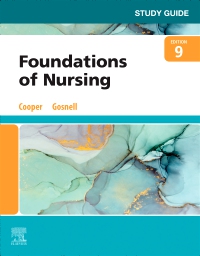

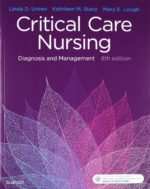

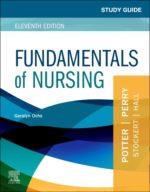
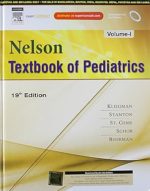
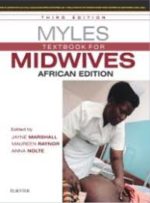


Be the first to review “Study Guide for Foundations of Nursing, 9th Edition”